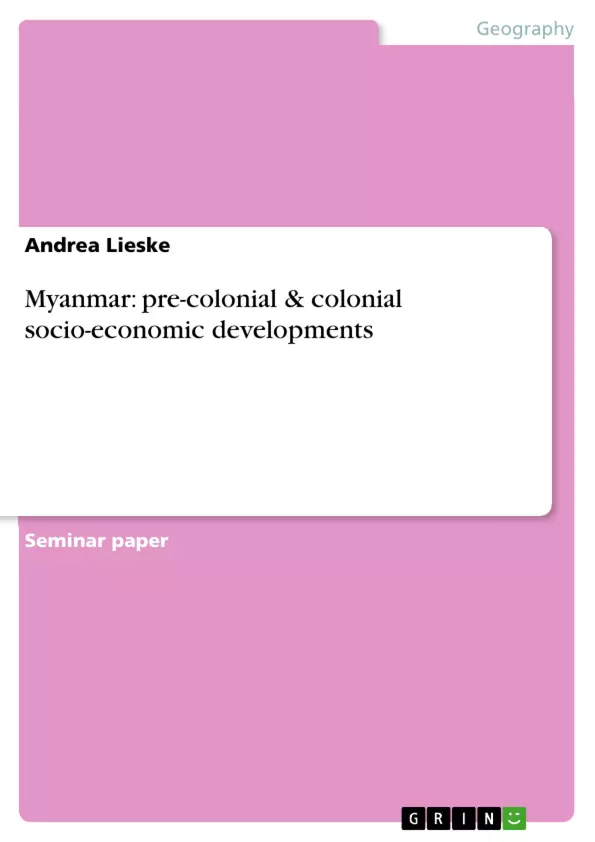Introduction
Modern-day Republic of the Union of Myanmar, formerly known as Burma, is shaped by its geographical idiosyncrasies and its history. Both factors are blended into the socio-economic developments of the country which are addressed in this paper. The focus here lies on the pre-colonial and colonial times. The names Burma and Myanmar are used equivalent and without political implications.
To approximate an assessment of those two phases, it is necessary start with a short introduction to the crucial geographic and historical factors affecting the social-economic developments until 1948, the year of Myanmar’s independence. The definition of the term socio-economic developments is allocated here as well.
Subsequently a short overview on the most important periods of Myanmar’s history is added. The following detailed description of history and socio-economic conditions and developments of three distinct periods, the Pyu city states, the Konbaung Dynasty and the British rule, enables a general view on the socio-economic developments of the time before the state’s independence in 1948.
This paper will proceed along one basic assumption: Independent of their time and their technological cultures all three Empires dealt with in this paper had to face the same difficulties: the scarcity of work force due to low density of population and the divide between the ‘rice basket’ Lower Myanmar and huge areas often depending on its supply of food in the rest of the country. Consequently the history of socio-economic development in Myanmar is hence the history of how each of the examined regimes dealt with those difficulties.
Table of content
Introduction
1. Geographic & historical basics of socio-economic developments until 1948
2. Overview: The history of Myanmar
3. Pyu City States (ca. 100 – 850 B.C.)
3.1. Pyu City States: Background
3.2. Pyu City states: Socio-economic conditions and developments
4. Socio-economic developments during the Konbaung Empire
4.1. Konbaung Empire: Background
4.2 Konbaung Dynasty: Socio-economic conditions and developments
5. Burma under British rule (1852 - 1948)
5.1. Burma under British rule: Background
5.2 Burma under British rule: Socio-economic conditions and developments
6. Conclusions: Socio-economic developments in Myanmar until 1948
7. Appendix
8. List of illustrations
9. Bibliography
Inhaltsverzeichnis (Table of Contents)
- Introduction
- Geographic & historical basics of socio-economic developments until 1948
- Overview: The history of Myanmar
- Pyu City States (ca. 100 – 850 B.C.)
- Pyu City States: Background
- Pyu City states: Socio-economic conditions and developments
- Socio-economic developments during the Konbaung Empire
- Konbaung Empire: Background
- Konbaung Dynasty: Socio-economic conditions and developments
- Burma under British rule (1852-1948)
- Burma under British rule: Background
- Burma under British rule: Socio-economic conditions and developments
- Conclusions: Socio-economic developments in Myanmar until 1948
Zielsetzung und Themenschwerpunkte (Objectives and Key Themes)
This paper examines the pre-colonial and colonial socio-economic developments in Myanmar, exploring the impact of geography, history, and political regimes on the country's economic and social structure. The analysis focuses on the period up to 1948, the year of Myanmar's independence. The paper uses the terms Burma and Myanmar interchangeably, without any political implications.- The influence of geographical factors, including topography, climate, and water availability, on socio-economic development.
- The impact of different political regimes, including the Pyu City States, the Konbaung Dynasty, and British rule, on socio-economic conditions.
- The significance of population density and labor force issues in shaping economic development.
- The role of agriculture, particularly rice cultivation, in the economic landscape of Myanmar.
- The impact of regional trade routes and transnational connections on economic activity.
Zusammenfassung der Kapitel (Chapter Summaries)
The introduction sets the context by highlighting the significance of geography and history in shaping Myanmar's socio-economic development. It defines the term "socio-economic developments" and establishes the focus of the paper on pre-colonial and colonial periods. Chapter 1 delves into the geographical and historical factors that have influenced socio-economic developments in Myanmar until 1948. It highlights the importance of topographical features, seasonal variations, and water availability for the country's socio-economic trajectory. This chapter also examines the impact of population density and labor force issues on development strategies throughout history. Chapter 2 provides a brief overview of Myanmar's history, focusing on the precolonial, colonial, and modern periods. The paper emphasizes the precolonial era, particularly the Pyu City States and the Konbaung Empire, to illustrate contrasting approaches to governance: independent city-states versus centralized dynasties. Chapter 3 delves into the Pyu City States, examining their background, socio-economic conditions, and key developments. It highlights the importance of trade, agriculture, and urban settlements in the development of the Pyu civilization. Chapter 4 focuses on the Konbaung Empire, exploring its background, socio-economic conditions, and key developments. The chapter examines the impact of the Konbaung Dynasty on population policies, agricultural practices, and trade relations. Chapter 5 examines the period of British rule in Burma, exploring its background, socio-economic conditions, and key developments. It highlights the impact of colonial policies on agriculture, infrastructure, and the social landscape. Chapter 6 draws conclusions about socio-economic developments in Myanmar until 1948, highlighting key trends, challenges, and the lasting impact of different regimes on the country's economic and social fabric.Schlüsselwörter (Keywords)
The main keywords and focal points of this paper include Myanmar, Burma, precolonial, colonial, socio-economic development, geography, history, population density, labor force, agriculture, rice cultivation, trade, Pyu City States, Konbaung Empire, British rule, and Theravada Buddhism. These terms encapsulate the key themes and research focus of the paper, exploring the complex interplay of historical, geographical, and socio-economic factors in shaping Myanmar's development trajectory.- Quote paper
- Andrea Lieske (Author), 2011, Myanmar: pre-colonial & colonial socio-economic developments, Munich, GRIN Verlag, https://www.grin.com/document/180330



